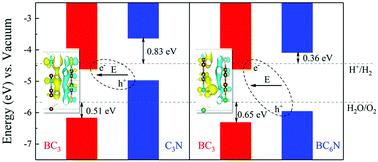当前位置:
X-MOL 学术
›
Phys. Chem. Chem. Phys.
›
论文详情
Our official English website, www.x-mol.net, welcomes your feedback! (Note: you will need to create a separate account there.)
2D van der Waals heterostructures of graphitic BCN as direct Z-scheme photocatalysts for overall water splitting: the role of polar π-conjugated moieties
Physical Chemistry Chemical Physics ( IF 3.3 ) Pub Date : 2020-10-12 , DOI: 10.1039/d0cp04219f Zhijie Wang 1, 2, 3, 4 , Zhibo Luo 1, 2, 3, 4 , Jia Li 1, 2, 3, 4 , Kang Yang 1, 2, 3, 4 , Gang Zhou 1, 2, 3, 4
Physical Chemistry Chemical Physics ( IF 3.3 ) Pub Date : 2020-10-12 , DOI: 10.1039/d0cp04219f Zhijie Wang 1, 2, 3, 4 , Zhibo Luo 1, 2, 3, 4 , Jia Li 1, 2, 3, 4 , Kang Yang 1, 2, 3, 4 , Gang Zhou 1, 2, 3, 4
Affiliation

|
The application of two-dimensional (2D) graphitic carbon-based materials in photocatalysis has been limited to date, because the nature and role of π-conjugated moieties in them remain unclear. Herein we propose and study bilayer BC3/C3N and BC3/BC6N van der Waals heterostructures as direct Z-scheme photocatalysts for overall water splitting using density functional theory calculations. The roles of polar π-conjugated moieties in the formation, stacking configuration, and electronic and optical properties of bilayer van der Waals heterostructures are discussed. It is shown that polar π-conjugated moieties of graphitic BCN monolayers lead to a favorable π–π interaction, determining the most stable stacking configuration, and a long-range charge transfer between components. The former makes the electronic band structure of heterostructures favor photocatalytic water splitting in efficiency and energetics. The latter generates a built-in electric field for the interface recombination of photogenerated electron–hole pairs, indicating a Z-scheme mechanism. The delocalized nature of π-conjugated electrons in monolayer components allows for high carrier mobility of bilayer heterostructures, promoting the photocatalytic reactions on graphitic BCN monolayers. These findings show that 2D π-conjugated materials, including graphitic carbon-based materials and biological systems, have great potential in the design and development of 2D metal-free direct Z-scheme photocatalysts for environmental purification and energy conversion.
中文翻译:

石墨BCN的2D van der Waals异质结构作为直接Z方案光催化剂用于整体水分解:极性π共轭基团的作用
迄今为止,二维(2D)石墨碳基材料在光催化中的应用受到限制,因为尚不清楚π共轭部分的性质和作用。在此,我们提出并研究双层BC 3 / C 3 N和BC 3 / BC 6使用密度泛函理论计算,将N van der Waals异质结构作为直接Z方案光催化剂用于整体水分解。讨论了极性π共轭部分在双层范德华异质结构的形成,堆叠构型以及电子和光学性质中的作用。结果表明,石墨BCN单层的极性π共轭部分可导致有利的π-π相互作用,从而确定最稳定的堆叠构型以及各组分之间的长距离电荷转移。前者使得异质结构的电子能带结构有利于光催化水分解的效率和能量。后者为光生电子-空穴对的界面复合产生了一个内置电场,表明了Z方案的机理。单层组件中π共轭电子的离域性质允许双层异质结构的高载流子迁移率,从而促进石墨BCN单层上的光催化反应。这些发现表明,包括石墨碳基材料和生物系统在内的二维π共轭材料在设计和开发用于环境净化和能量转换的二维无金属直接Z型光催化剂方面具有巨大潜力。
更新日期:2020-10-16
中文翻译:

石墨BCN的2D van der Waals异质结构作为直接Z方案光催化剂用于整体水分解:极性π共轭基团的作用
迄今为止,二维(2D)石墨碳基材料在光催化中的应用受到限制,因为尚不清楚π共轭部分的性质和作用。在此,我们提出并研究双层BC 3 / C 3 N和BC 3 / BC 6使用密度泛函理论计算,将N van der Waals异质结构作为直接Z方案光催化剂用于整体水分解。讨论了极性π共轭部分在双层范德华异质结构的形成,堆叠构型以及电子和光学性质中的作用。结果表明,石墨BCN单层的极性π共轭部分可导致有利的π-π相互作用,从而确定最稳定的堆叠构型以及各组分之间的长距离电荷转移。前者使得异质结构的电子能带结构有利于光催化水分解的效率和能量。后者为光生电子-空穴对的界面复合产生了一个内置电场,表明了Z方案的机理。单层组件中π共轭电子的离域性质允许双层异质结构的高载流子迁移率,从而促进石墨BCN单层上的光催化反应。这些发现表明,包括石墨碳基材料和生物系统在内的二维π共轭材料在设计和开发用于环境净化和能量转换的二维无金属直接Z型光催化剂方面具有巨大潜力。


























 京公网安备 11010802027423号
京公网安备 11010802027423号